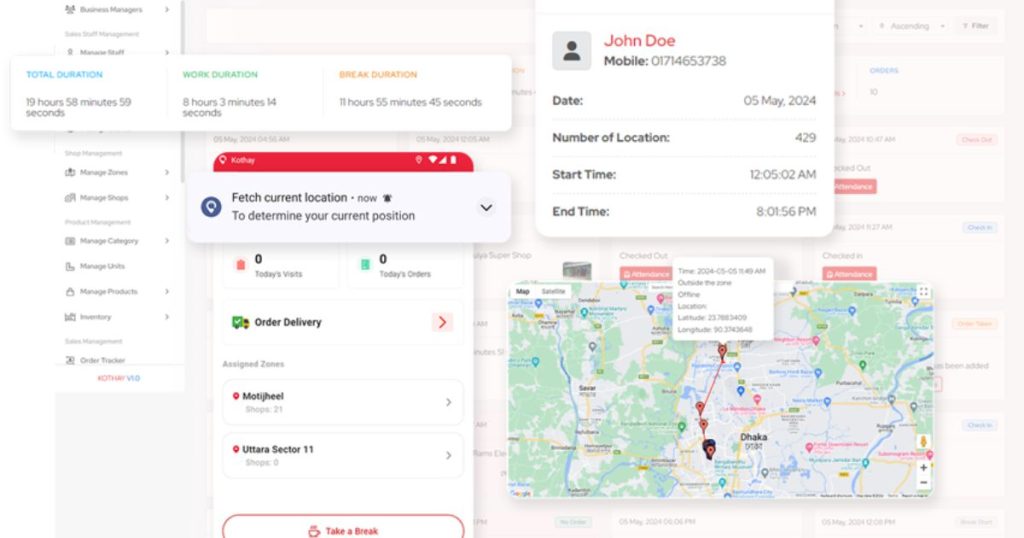Sales Activity Report: Your Complete Guide to
If you’re managing sales, you already know it’s not...

In the world of modern sales management, two distinct tracking systems are commonly used: sales tracking and salesman tracking software. While they may sound similar, they serve completely different functions in a business setting.
Salesman tracking software is a tool that allows businesses to monitor, manage, and analyze the performance of their sales teams, including their field operations and customer interactions.
This guide will help you understand:
Although some apps, especially Kothay App, can serve both purposes, you should understand the real difference between tracking your sales pipeline and tracking your field salesforces.
So, let’s break it down.

GPS-based Salesman tracking is a method of monitoring the real-time movement and activity of your field sales team using digital tools like mobile apps and GPS. It focuses on visibility, like where your sales reps are, which clients they’ve visited, how long they stayed, and what actions were completed.
Salesman tracking is essential for companies that rely on face-to-face sales interactions and have a dispersed sales force covering different locations. This is the ideal system for fieldforce management.

Salesman tracking apps give managers a live map of their team’s location and movements. This helps you verify if reps are following their schedules or wasting time. For example, if a sales rep claims to have visited 10 locations, GPS-based logs can confirm those visits and time spent per client.
When you track movement history, you can identify inefficient travel patterns. This data helps optimize routes, reduce fuel costs, and ensure reps aren’t overbooking or underperforming.
Tracking tools ensure reps stick to their responsibilities. When they know their movements and visits are logged, there’s a natural improvement in punctuality and professionalism.
You can easily see which clients have been missed or visited too frequently. This allows you to allocate reps more effectively and avoid over-servicing or client neglect.

Sales reps may feel uncomfortable knowing their every move is tracked. To avoid pushback, companies must clearly explain the purpose and benefits and avoid micromanagement.
Flawless connectivity is a very big challenge in countries like Bangladesh. Poor mobile connectivity, GPS issues, or battery drain can sometimes lead to inaccurate logs or missed check-ins. Reps in rural or low-signal areas may face limitations.
If your team is not used to using apps or digital tools, adoption might be slow. User-friendly design and proper onboarding are essential.
Tracking should improve productivity, not turn into surveillance. Excessive control can demotivate reps and create a toxic culture if not managed wisely.
Sales tracking is the process of monitoring the progress of your deals, revenue pipeline, sales goals, and individual rep performance. It focuses on outcomes. For example, how many leads converted, the average deal size, sales targets achieved, and pipeline movement.
Unlike salesforce management, which is movement-based, sales pipeline tracking is performance-based.

With a robust sales activity tracking system, you can view your team’s performance in real-time. From closed deals to conversion rates, it gives you a pulse on what’s working and what’s not. For example, you can identify that a rep has high meeting activity but low close rates, a signal for coaching.
Real time sales tracking helps you predict revenue based on current deal stages. You can estimate this month’s or quarter’s results based on weighted pipelines and historical trends.
If leads keep getting stuck at a certain funnel stage (like pricing or negotiation), sales tracking highlights these friction points so you can fix them.
Sales dashboards show real-time progress toward targets, helping teams stay motivated. Reps can see where they stand and what they need to do to hit quotas.
CRM sales tracking tools are only as good as the data entered. If reps forget to log activities or update pipeline stages, reports can become misleading.
Sales tracking works best when integrated with CRMs, email, and calendar tools. If your systems don’t sync well, you might face double work or data silos.
Too many charts and KPIs can be confusing. You need to decide which metrics truly matter: revenue, win rate, or deal velocity, and focus those.
For consistent tracking, your team must adopt a habit of regular updates. Without buy-in, the system becomes outdated quickly.
| Feature | Salesman Tracking | Sales Tracking |
| Core Purpose | Monitor field reps and their movements | Monitor sales process and deal outcomes |
| Used By | Sales supervisors, field team managers | Sales directors, business analysts |
| Focus | Real-time location, visit logs | CRM pipeline, deal stages, KPIs |
| Tools Typically Used | GPS tracking app, check-in software | CRM, dashboards, analytics tools |
| KPIs Tracked | Visits per day, time per client, routes | Revenue, win rate, sales funnel conversions |
| Best For | Companies with field sales force | Any sales-driven business or agency |
| Integration Needs | Low (can work standalone) | High (needs CRM/email/calendar sync) |
The answer depends on your operations:

Kothay.app is a modern, lightweight, and versatile sales team management software. It is a sales tracking solution designed for growing businesses that need both salesperson tracking and sales performance monitoring without the complexity.
Track your field reps’ location, visited clients, and time spent at each site. Built-in GPS and visit logs let you verify activity without calling each rep.
Get clear insights into each rep’s daily performance, visit count, and target completion — all from a single screen.
Reps can log visits, take notes, and share photos as proof, reducing false reporting and increasing transparency with the help of zone management.
Built-in tools help managers share instructions, review reports, and give feedback quickly.
Both Android and desktop versions are optimized for speed, simplicity, and clarity, even in low-connectivity areas.
Both salesman tracking and sales tracking play critical roles in managing a modern sales force. One keeps your feet on the street accountable, while the other keeps your pipeline moving.
If you want a lightweight, unified platform to track where your reps are and how they’re performing, then Kothay.app is the solution your business deserves.
The best way to keep track of sales is by using a sales CRM or tracking software. In Bangladesh, the most popular sales management apps are Hubspot and Kothay.
Use sales fieldforce management tools to track and monitor employee performance. Features like geofencing and automated sales updates also keep their activities in check.
Total revenue, conversion rate, average deal size, sales cycle length, and win rate. Combining all these metrics helps to report the exact condition of any sales pipeline and forecast the most viable outcome.
The most efficient way is to use the Kothay App. In Bangladesh, Kothay is the most budget-friendly option, featuring around $1.5/employee at basic mode.